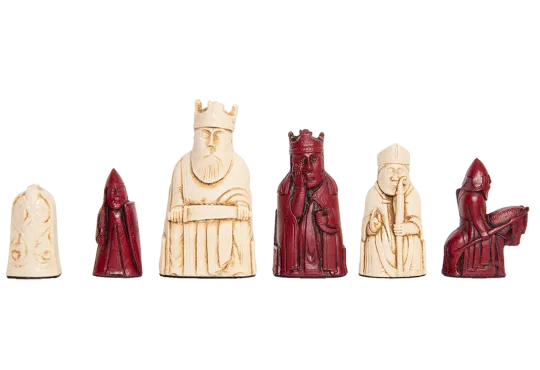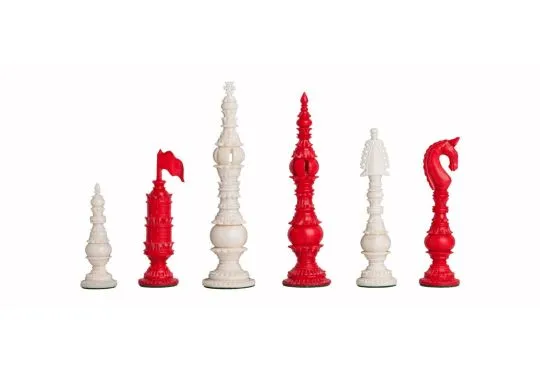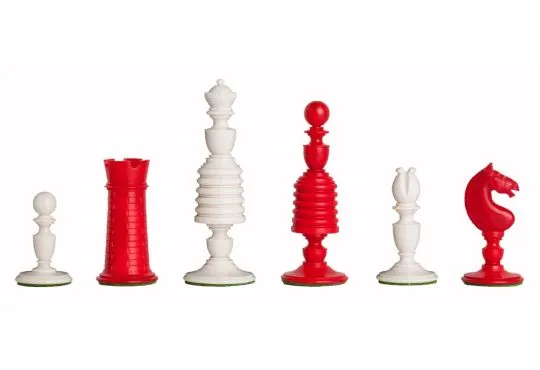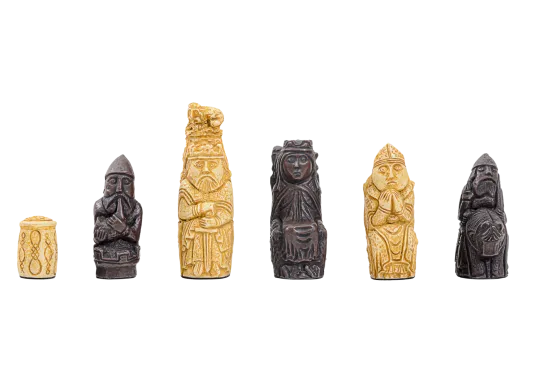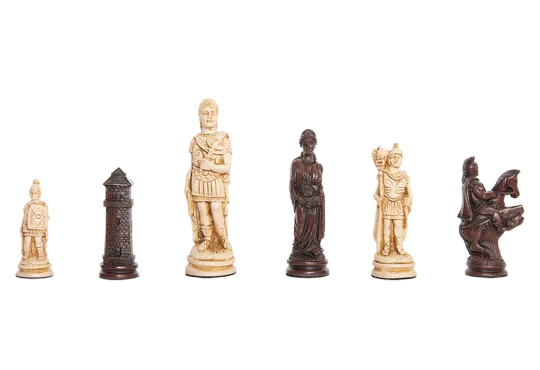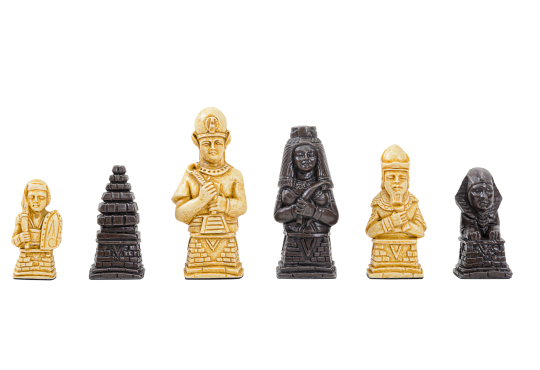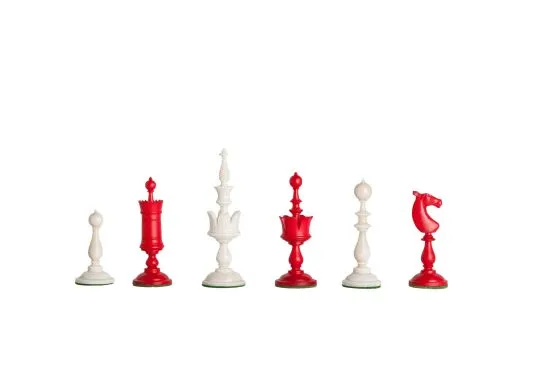6 Interesting Chess Sets You Should Know About
Have you ever thought how some chess sets can reveal years, even centuries, of history and culture? These interesting chess sets offer more than just ornamental beauty — they tell stories of the lost civilizations and artisans that molded them.
They connect us to different cultures and eras.
From medieval Spain to ancient Persia — each set is unique and reflects the influence of the era in its craftsmanship.
Today, we are looking into some of the most interesting chess sets, uncover their origins, and their lasting effects.
Table of contents
6 Interesting Chess Sets From Around The World
Everyone knows that chess originated in India around the 6th century from the game Chaturanga. From there, it spread to Persia, where it became Chatrang, and eventually to the Arab world, where it became Shatranj.
As chess traveled the world, it adopted various cultures, absorbing inspiration along the way. So, let’s take a deeper look at some of the most interesting chess pieces, starting with the Lewis Chessmen.
1. Lewis Chessmen
We have to start off the list with one of our favorite chess boards of all time – the Lewis Chessmen.
What is fascinating about this chess set is the rumors surrounding its origins. The most common story we found suggests a crofter named Malcolm MacLeod accidentally stumbled upon them in Uig Bay.
But, our favorite rumor suggests a Highlander mistook the pieces for elves and fled in horror, only to retrieve them later.

What makes this one of the most interesting chess sets is how each piece reflects Norse culture. The artists depicted the rooks biting their shields, mimicking the berserkers.
You know what’s incredible? This detail reveals the connection between the chess pieces and Viking culture.
Scholars claim a Norwegian king might have gifted the set to the local rulers to strengthen ties between Norway and the Isles.
Long story short, the Lewis Chessmen sure have left us with more questions than answers.
Did you know that you can see these beautiful pieces at the National Museum of Scotland and the British Museum?
If you do get a chance to see them, you might wonder what exactly they are made of. So, Scottish scholars thoroughly examined the pieces and found the artisan primarily carved them from walrus ivory and whale teeth.
The chess pieces remain very well-preserved, and it’s because someone stored them in a leather bag for protection.
-
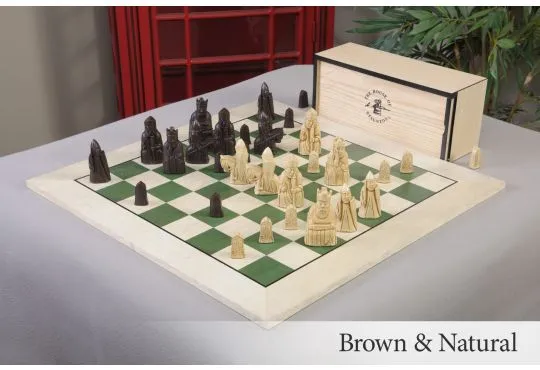 Free Worldwide Shipping
The Isle of Lewis Chess Set, Box, & Board Combination Enjoy Savings of 32% Off MSRP When Purchased as a Combination
Free Worldwide Shipping
The Isle of Lewis Chess Set, Box, & Board Combination Enjoy Savings of 32% Off MSRP When Purchased as a Combination$597.95
Starting at $409.00
To $518.95
-
 Free Worldwide Shipping
The Mini Isle of Lewis Series Chess Pieces - 2.0" King - Brown and Natural
Free Worldwide Shipping
The Mini Isle of Lewis Series Chess Pieces - 2.0" King - Brown and NaturalStarting at $149.00
To $567.95
2. Mozarabic Set
Found in León, Spain, the Mozarabic chess set is a fascinating example of early chess in Europe.
What really stands out about this set is the craftsmanship. It’s different from the other chess pieces on our lists because they are made of deer antlers.
These chess pieces are also known as the Pieces of Saint Genadion and are closely tied to the Mozarabs, Spanish Christians who lived under Muslim rule.
Here’s where things get interesting!
The Mozarabs helped forge cultural connections between the Christian and Muslim communities, with chess playing a key role. Scholars attribute the pieces to Genadio de Astorga, a Christian bishop from the 10th century.
Now you’re probably wondering: why is that an important detail?
Genadio played a key role in establishing Christian monasteries in Northern Spain during the Reconquista (the centuries-long effort led by Christian kingdoms to reclaim territory from Muslim rule in Spain). He was closely affiliated with the monastery where the chess pieces are now kept.
Experts believe Mozarabic monks used these chess pieces for spiritual and intellectual routines.
The four pieces display Islamic designs and are made of ivory, and are distinguished by the abstract shapes. Unlike the more figurative designs popular in the European chess sets, these pieces are geometric and minimalistic.
Some believe the Mozarabic chess pieces helped spread chess throughout northern Spain and into Europe. We think it’s one of the most interesting chess sets because it gives us insight into the cultural connection between the Muslim and Christian communities of the past.
You see, the Mozarabic community promoted the exchange of ideas, chess, and art across Europe.
This set reminds us of how cultures blend and enrich each other, even in the midst of political and religious conflicts.
3. Charlemagne Chess Set
The Charlemagne chess set is definitely one of the most interesting chess sets out there, and there are legends and rumors surrounding its origins.
The chessmen, made from ivory in the 11th century, currently reside in Cabinet des Médailles in Paris.
Before we jump into what makes this chess set so special, let’s look into some of the rumors around it. A popular story claims Caliph Harun-al-Rashid, a chess enthusiast, gave these chess pieces as a gift to Charlemagne.
The chess board features elephants instead of bishops and chariots instead of rooks. This design reflects Shatranj, which, if true, means chess was played in Europe much earlier than we thought.
But the stories and theories don’t end there!
There are a few ancient sources that suggest that Notker the Stammerer, who wrote about Charlemagne in the 880s, claimed the Caliph gifted a real elephant, not a chess set.
We found other historical records that claim the chess set was a gift from the Byzantine Empress Irene, though this is yet to be proven.
The Treasury of Saint-Denis Abbey in Paris kept the 30-piece set from the 13th to the 18th centuries.
Sadly, during the French Revolution, many revolutionaries seized the abbey’s treasures. Only 16 pieces were recovered and sent to the Cabinet des Médailles in 1794.
The remaining 16 pieces include two kings, two queens, three rooks, four knights and elephants, and one pawn. Thankfully, the pieces remain well-preserved, and their delicate carvings show the craftsmanship and influence of the era.
-
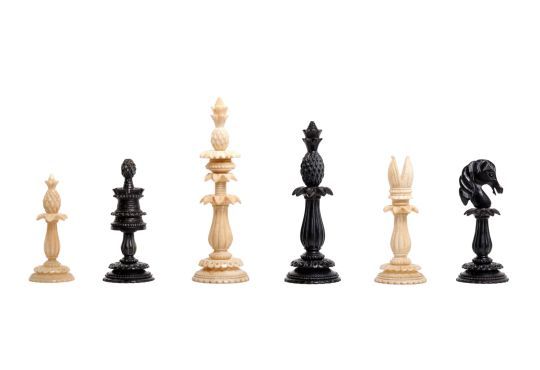 Free Worldwide Shipping
The Lund Anglo-Indian Reproduction Luxury Bone Chess Pieces - 4.75" King
Free Worldwide Shipping
The Lund Anglo-Indian Reproduction Luxury Bone Chess Pieces - 4.75" KingStarting at $1,495.00
To $7,629.95
4. Ager Chessmen
The Ager Chessmen are easily one of the most unique looking chess pieces in our list. According to historians, these pieces date back to the 11th century – the time of Arnau Mir de Tost, the powerful lord and knight of Urgell.
He reconquered Ager from the Saracens (people who lived around the Arabian Peninsula and Syrian Desert) in northern Spain.
So, where do the chess pieces fit in?
There are documents that suggest that Ersenda d’Ager, Arnau’s wife, mentioned the Ager chessmen in her 1068 will, and Arnau included them in his 1071 will.
After careful study and analysis, historians link the chessmen to Catalonia, where chess spread through cultural interactions between the Islamic and Christian communities. The late professor Ricardo Calvo claimed the original set included 96 pieces, but by the early 19th century, only 44 remained.
The Emir of Kuwait bought the chessmen at a public auction. However, during the Gulf War, Iraqi soldiers plundered the treasures, and after several recovery efforts, the chessmen returned to Kuwait.
By now, you must be wondering, what makes this chess set so unique?
The Ager Chessmen are one of the most interesting chess sets out there because artisans carved them from rock crystals, a precious material during the middle ages. The beautifully abstract geometric design reflects Islamic traditions and the unique medium points to a foreign origin, likely from Fatimid Egypt (known for their intricate stone carvings).
As of right now, the chess pieces reside in Kuwait and in the Museum de Lleida.
5. Afrasiab Chessmen
Archaeologist Jurjij F. Burjakov found the Afrasiab chess pieces during an excavation near Afrasiab in 1977. The ancient site was close to Samarkand in Uzbekistan, and the dig was led by the Uzbekistan Academy of Archaeology.
As we already discussed earlier, chess spread through Persia, Turkey, and the Middle East. So the discovery of the chess pieces on a historic silk road proves how chess traveled with scholars and traders along important trade routes.
The Afrasiab chessmen, made from ivory, consist of seven pieces, and date back to between the late 6th and early 8th centuries.
An incredible study by Prof. Yuriy Buryakov of the Uzbek SSR Academy of Archaeology suggests that the pieces were likely made during the end of the Sassanid Empire, just before the Arab conquest of Persia.
The craftsmanship of these chess pieces is something we can’t help but admire.
Despite the wear and tear, the chessmen, consisting of two pawns, a bishop, a queen, two knights, and a king, display incredibly realistic figures and battle equipment.
What’s incredible about this design is that they tell us a lot about Sassanid culture – the kind of society that existed and the warfare during that time.
The Afrasiab Chessmen currently reside in the State Museum of Samarkand. They stand as proof of the cultural exchange, the link with the Sassanid Empire, and how the game evolved in Central Asia.
6. Selenus Chess Set
Not only are the Selenus chess pieces one of the most interesting chess sets out there, it's also one of the prettiest ones.

It’s said that chess players in Germany and Northern Europe used this style of chess, named after Gustavus Selenus, the pen name of Augustus the Younger, Duke of Brunswick-Lüneburg.
He wrote The Chess or the King’s Game, a chess manual that was very influential.
The Selenus chess set stuns with delicate lathe-turned bases, slender shafts, and tiers of circlets that resemble crowns. Some people call it the Garden Chess Set because of its floral-inspired designs.
It is referred to as the Tulip Chess Set in England because of its gentle, tulip-like shapes.
The bone and ivory pieces showcase the incredible craftsmanship of the time. The chess set ruled over chess tables in Germany and Europe for nearly two centuries, and remains, to this day, a favorite among chess collectors and historians.
-
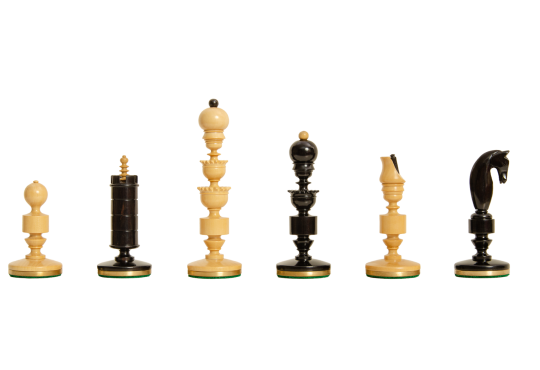 Free Worldwide Shipping
The Camaratta Collection - The Biedermeier Series Luxury Chess Pieces - 4.4" King From the Camaratta Collection
Free Worldwide Shipping
The Camaratta Collection - The Biedermeier Series Luxury Chess Pieces - 4.4" King From the Camaratta CollectionStarting at $1,029.00
To $7,719.00
-
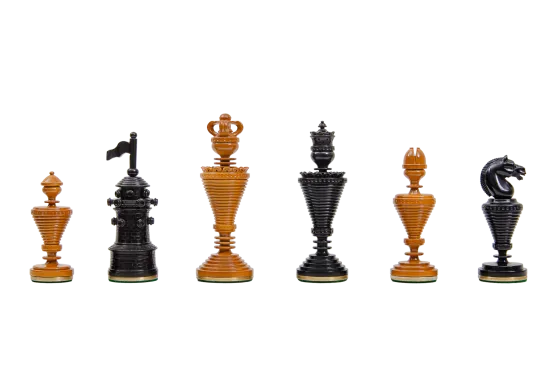 Free Worldwide Shipping
The Anglo-Dutch Reproduction Series Luxury Wood Chess Pieces - 4.75" King
Free Worldwide Shipping
The Anglo-Dutch Reproduction Series Luxury Wood Chess Pieces - 4.75" KingStarting at $1,649.00
To $7,783.95
Wrapping Up
We had a lot of fun going through the different chess pieces, their historical and significance, and curating a list of some of the most interesting chess sets out there.
What you may have noticed is that these chess pieces offer more than just a way to play the game. They tell stories and show the elaborate and intricate craftsmanship, the cultures, and their influence.
If you think these chess sets would make incredible additions to your collections. We recommend you check out our vast selection of models and find the chess board that fits your style.


